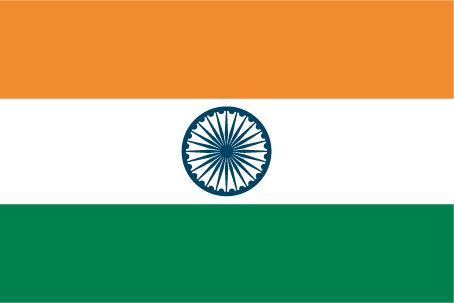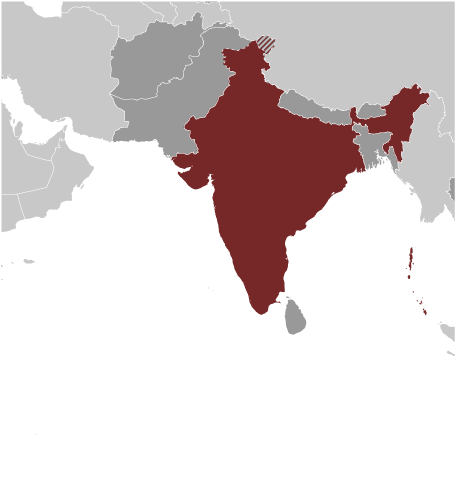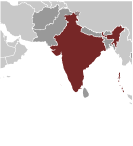
|
|
Advertisements:
People And SocietyNationality
Noun Indian(s)
Adjective Indian Ethnic groups
Indo-Aryan 72%, Dravidian 25%, Mongoloid and other 3% (2000) Languages
Hindi 41%, Bengali 8.1%, Telugu 7.2%, Marathi 7%, Tamil 5.9%, Urdu 5%, Gujarati 4.5%, Kannada 3.7%, Malayalam 3.2%, Oriya 3.2%, Punjabi 2.8%, Assamese 1.3%, Maithili 1.2%, other 5.9% Note English enjoys the status of subsidiary official language but is the most important language for national, political, and commercial communication; Hindi is the most widely spoken language and primary tongue of 41% of the people; there are 14 other official languages: Bengali, Telugu, Marathi, Tamil, Urdu, Gujarati, Malayalam, Kannada, Oriya, Punjabi, Assamese, Kashmiri, Sindhi, and Sanskrit; Hindustani is a popular variant of Hindi/Urdu spoken widely throughout northern India but is not an official language (2001 census) Religions
Hindu 80.5%, Muslim 13.4%, Christian 2.3%, Sikh 1.9%, other 1.8%, unspecified 0.1% (2001 census) Population World Ranking: 2
1,205,073,612 (July 2012 est.)
Age structure
0-14 years
29.7% (male 187,450,635/female 165,415,758) 15-64 years 64.9% (male 398,757,331/female 372,719,379) 65 years and over 5.5% (male 30,831,190/female 33,998,613) (2011 est.) Median age
Total 26.5 years
Male 25.9 years Female 27.2 years (2012 est.) Population growth rate World Ranking: 88
1.312% (2012 est.)
Birth rate World Ranking: 85
20.6 births/1,000 population (2012 est.) Death rate World Ranking: 116
7.43 deaths/1,000 population (July 2012 est.) Net migration rate World Ranking: 116
-0.05 migrant(s)/1,000 population (2012 est.) Urbanization
Urban population 30% of total population (2010)
Rate of urbanization 2.4% annual rate of change (2010-15 est.) Major cities - population
NEW DELHI (capital) 21.72 million; Mumbai 19.695 million; Kolkata 15.294 million; Chennai 7.416 million; Bangalore 7.079 million (2009) Sex ratio
At birth 1.12 male(s)/female
Under 15 years 1.13 male(s)/female 15-64 years 1.07 male(s)/female 65 years and over 0.9 male(s)/female Total population 1.08 male(s)/female (2011 est.) Maternal mortality rate World Ranking: 54
200 deaths/100,000 live births (2010) Infant mortality rate World Ranking: 50
Total 46.07 deaths/1,000 live births
Male 44.71 deaths/1,000 live births Female 47.59 deaths/1,000 live births (2012 est.) Life expectancy at birth World Ranking: 160
Total population 67.14 years
Male 66.08 years Female 68.33 years (2012 est.) Total fertility rate World Ranking: 80
2.58 children born/woman (2012 est.) Health expenditures World Ranking: 185
2.4% of GDP (2009)
Physicians density
0.599 physicians/1,000 population (2005) Hospital bed density
0.9 beds/1,000 population (2005) Hiv/aids - adult prevalence rate World Ranking: 84
0.3% (2009 est.)
Hiv/aids - people living with hiv/aids World Ranking: 3
2.4 million (2009 est.)
Hiv/aids - deaths World Ranking: 3
170,000 (2009 est.)
Major infectious diseases
Degree of risk High
Food or waterborne diseases Bacterial diarrhea, hepatitis A and E, and typhoid fever Vectorborne diseases Chikungunya, dengue fever, Japanese encephalitis, and malaria Animal contact disease RabiesWater contact disease Leptospirosis Note Highly pathogenic H5N1 avian influenza has been identified in this country; it poses a negligible risk with extremely rare cases possible among US citizens who have close contact with birds (2009) Children under the age of 5 years underweight World Ranking: 1
43.5% (2006)
Education expenditures World Ranking: 129
3.1% of GDP (2006)
Literacy
Definition
Age 15 and over can read and write Total population 61%Male 73.4% Female 47.8% (2001 census) School life expectancy (primary to tertiary education)
Total 10 years
Male 11 years Female 10 years (2007) Unemployment, youth ages 15-24 World Ranking: 100
Total 10.5%
Male 10.4% Female 10.8% (2004)
Comments
Add a new comment: |
Advertisement
Members area
India (New Delhi):
 
GPS points from India (New Delhi)
|
||||||||

 The Indus Valley civilization, one of the world's oldest, flourished during the 3rd and 2nd millennia B.C. and extended into northwestern India. Aryan tribes from the northwest infiltrated onto the Indian subcontinent about 1500 B.C.; their merger with the earlier Dravidian inhabitants created the classical Indian culture. The Maurya Empire of the 4th and 3rd centuries B.C. - which reached its zenith under ASHOKA - united much of South Asia. The Golden Age ushered in by the Gupta dynasty (4th to 6th centuries A.D.) saw a flowering of Indian science, art, and culture. Islam spread across the subcontinent over a period of 700 years. In the 10th and 11th centuries, Turks and Afghans invaded India and established the Delhi Sultanate. In the early 16th century, the Emperor BABUR established the Mughal Dynasty which ruled India for more than three centuries. European explorers began establishing footholds in India during the 16th century. By the 19th century, Great Britain had become the dominant political power on the subcontinent. The British Indian Army played a vital role in both World Wars. Nonviolent resistance to British rule, led by Mohandas GANDHI and Jawaharlal NEHRU, eventually brought about independence in 1947. Communal violence led to the subcontinent's bloody partition, which resulted in the creation of two separate states, India and Pakistan. The two countries have fought three wars since independence, the last of which in 1971 resulted in East Pakistan becoming the separate nation of Bangladesh. India's nuclear weapons tests in 1998 caused Pakistan to conduct its own tests that same year. In November 2008, terrorists originating from Pakistan conducted a series of coordinated attacks in Mumbai, India's financial capital. In January 2011, India assumed a nonpermanent seat in the UN Security Council for the 2011-12 term. Despite pressing problems such as significant overpopulation, environmental degradation, extensive poverty, and widespread corruption, rapid economic development is fueling India's rise on the world stage.
The Indus Valley civilization, one of the world's oldest, flourished during the 3rd and 2nd millennia B.C. and extended into northwestern India. Aryan tribes from the northwest infiltrated onto the Indian subcontinent about 1500 B.C.; their merger with the earlier Dravidian inhabitants created the classical Indian culture. The Maurya Empire of the 4th and 3rd centuries B.C. - which reached its zenith under ASHOKA - united much of South Asia. The Golden Age ushered in by the Gupta dynasty (4th to 6th centuries A.D.) saw a flowering of Indian science, art, and culture. Islam spread across the subcontinent over a period of 700 years. In the 10th and 11th centuries, Turks and Afghans invaded India and established the Delhi Sultanate. In the early 16th century, the Emperor BABUR established the Mughal Dynasty which ruled India for more than three centuries. European explorers began establishing footholds in India during the 16th century. By the 19th century, Great Britain had become the dominant political power on the subcontinent. The British Indian Army played a vital role in both World Wars. Nonviolent resistance to British rule, led by Mohandas GANDHI and Jawaharlal NEHRU, eventually brought about independence in 1947. Communal violence led to the subcontinent's bloody partition, which resulted in the creation of two separate states, India and Pakistan. The two countries have fought three wars since independence, the last of which in 1971 resulted in East Pakistan becoming the separate nation of Bangladesh. India's nuclear weapons tests in 1998 caused Pakistan to conduct its own tests that same year. In November 2008, terrorists originating from Pakistan conducted a series of coordinated attacks in Mumbai, India's financial capital. In January 2011, India assumed a nonpermanent seat in the UN Security Council for the 2011-12 term. Despite pressing problems such as significant overpopulation, environmental degradation, extensive poverty, and widespread corruption, rapid economic development is fueling India's rise on the world stage.